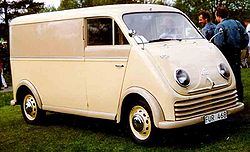
DKW van
Encyclopedia



Van
A van is a kind of vehicle used for transporting goods or groups of people.In British English usage, it can be either specially designed or based on a saloon or sedan car, the latter type often including derivatives with open backs...
produced by DKW from 1949 to 1962 in a one box or monospace configuration featuring front wheels set forward in the passenger cabin, a short sloping aerodynamic hood, front wheel drive, transverse engine
Transverse engine
A transverse engine is an engine mounted in a vehicle so that the engine's crankshaft axis is perpendicular to the long axis of the vehicle. Many modern front wheel drive vehicles use this engine mounting configuration...
, flat load floor throughout with flexible seating and cargo accommodations.
These same features make theSchnellaster a precursor of the modern minivan
Minivan
Minivan is a type of van designed for personal use. Minivans are typically either two-box or one box designs for maximum interior volume – and are taller than a sedan, hatchback, or a station wagon....
, a body configuration subsequently popularized in notable examples such as the Renault Espace
Renault Espace
The Renault Espace is a large MPV from French car-maker Renault. Generations 1-3 were sold under the Renault brand but manufactured by Matra. The current fourth generation model, which seats seven passengers, is an all-Renault product; the Renault Grand Espace is a long-wheelbase version with...
, Chrysler Voyager/Caravan
Dodge Caravan
The Dodge Caravan is a family minivan manufactured by Chrysler Group LLC and sold under its Dodge brand. Along with its nameplate variant, the Plymouth Voyager, the Caravan was introduced for the 1984 model year. In 1987, the Dodge Grand Caravan long-wheelbase model was introduced and sold...
or Kia Carnival/Sedona
Kia Carnival
The Kia Carnival is a minivan manufactured by Kia Motors, introduced in September 1998, now in its second generation and marketed globally under various nameplates – prominently as the Kia Sedona....
(pictured right).
The van included a trailing-arm rear suspension
Rear suspension
For front-wheel drive cars, rear suspension has few constraints and a variety of beam axles and independent suspensions are used.For rear-wheel drive cars, rear suspension has many constraints and the march to the superior but more expensive independent suspension layout has been a long slog...
system incorporating springs
Spring (device)
A spring is an elastic object used to store mechanical energy. Springs are usually made out of spring steel. Small springs can be wound from pre-hardened stock, while larger ones are made from annealed steel and hardened after fabrication...
in the cross bar assembly. The modern layout featured a prewar two-cylinder 700 cc two-stroke engine of the DKW F8
DKW F8
The DKW F8 compact front-wheel drive two-stroke engined saloon was introduced by in 1939. The F8 was slightly shorter than its predecessor despite having a marginally increased wheelbase. The base model, known as the Reichsklasse, was manufactured only till 1940 but the Meisterklasse sedan...
rated at 20 hp (22 hp after 1952). In 1955 the van received the DKW F9
DKW F9
The DKW F9 was the prototype of a car Auto Union intended to launch as a successor to the DKW F8.The small DKWs were among top selling small cars in Germany in the 1930s, and regular model updates were part of the company's strategy for maintaining commercial success in this growing market sector...
's three cylinder unit with 900 cc, producing 32 hp.
The van's layout enabled a floor 40 cm (16 in) off the ground. It was also fitted with a large single rear door fitted to hinge
Hinge
A hinge is a type of bearing that connects two solid objects, typically allowing only a limited angle of rotation between them. Two objects connected by an ideal hinge rotate relative to each other about a fixed axis of rotation. Hinges may be made of flexible material or of moving components...
s on the right-hand side.
The van was also produced in Vitoria
Vitoria-Gasteiz
Vitoria-Gasteiz is the capital city of the province of Álava and of the autonomous community of the Basque Country in northern Spain with a population of 235,661 people. It is the second largest Basque city...
, Spain, by Industrias del Motor S.A. (IMOSA) from 1954. In Spain, DKW became a common term for any van, and is still used today. The Spanish subsidiary also produced a modern successor, introduced in 1963 and called DKW F 1000 L. This van started with the three cylinder 980 cc two-stroke DKW engine, but later received a Mercedes-Benz
Mercedes-Benz
Mercedes-Benz is a German manufacturer of automobiles, buses, coaches, and trucks. Mercedes-Benz is a division of its parent company, Daimler AG...
Diesel engine
Diesel engine
A diesel engine is an internal combustion engine that uses the heat of compression to initiate ignition to burn the fuel, which is injected into the combustion chamber...
and finally was renamed a Mercedes-Benz in 1975.
In 1969 the DKW van was manufactured under licence by Industrias Automotriz de Santa Fe (IASFe) in Argentina, though for only one year, after producing the "Schnellaster" the previous 10 years, the factory had closed its doors, but Industrias Mecánicas del Estado (IME) continued its production as the Rastrojero Frontalito F 71 / SM 81 from 1969 until 1979 in pickup, minibus and van versions.

